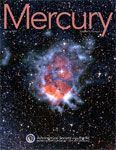Spring 2010 - Volume 39, Number 2

Table of Contents
[16] Wanted: A STEM Workforce, Michael G. Gibbs
A number of institutions of higher education are working to address the national need to develop and educate our nation’s future STEM workforce and leaders, but it’s no small task.
[20] The Universe Brought Down to the Streets, Megan Watzke and Kimberly Arcand
Public exhibits in parks, airports, libraries, shopping centers, art festivals, nature centers and even prisons promote scientific awareness to millions of people worldwide.
[25] Gamma-Ray Bursts: Piecing Together a Cosmic Puzzle, Zach Cano
These high-energy blasts continue to mystify, so astronomers are stepping up their search for the key pieces to the puzzle.
[31] Astronomy in the News
A stationary Martian explorer, double aurora on Saturn, and new results from WMAP -- these are some of the discoveries that recently made news in the astronomical community.
Departments
[4] Editorial, Paul Deans
Revisiting History
[5] First Word, James G. Manning
Moveable Feasts
[7] Echoes of the Past, Katherine Bracher
30 Years Ago: Exploring Jupiter’s Satellites
[8] Annals of Astronomy, Clifford J. Cunningham
Newton’s Mistakes
[9] Astronomer's Notebook, Jennifer Birriel
Astronomy with Digital Cameras
[10] Planetary Perspectives, Daniel D. Durda
Feeling Blue -- But in a Very Good Way
[11] Armchair Astrophysics, Christopher Wanjek
The Gamma-Ray Sky: Still a Mystery
[12] Education Matters, David Bruning
The Blame Game
[13] Reaching Out, James Lochner
Anyone Can be an Astronomy Educator
[14] Societal Impact, David Bruning and Andrew Fraknoi
Cultivate Your Teaching at Cosmos 2010
[37] Society Scope/ASP Supporters
Award Winners
[42] Sky Sights, Paul Deans
A Celestial Beacon at Sunset
[45] Reflections, Zach Cano
Two Hours in the Life …
Wanted: A STEM Workforce
by Michael G. Gibbs
As a cause-based organization, the Astronomical Society of the Pacific (ASP) strives to improve science literacy through the enjoyment of astronomy within the United States and internationally. This mission is implemented by working in partnership with the intermediate communicators who interact and educate both children and the public. This important mission is shared with other organizations that also seek to increase the knowledge of our nation in the fields of science, technology, engineering and mathematics (STEM).
While the ASP works with numerous organizations that share in its mission, there are still others who continue the pipeline of developing and educating our nation’s future STEM workforce and leaders. One such organization is Capitol College.
Recently, Capitol College established the Center for Space Science Education and Public Outreach. The Center provides hands-on educational and workforce development experiences for K–12, community college, and college students (and those who support them) in achieving leadership careers in STEM fields.
The Universe Brought Down to the Streets
by Megan Watzke and Kimberly Arcand
The International Year of Astronomy 2009 (IYA2009) brought an unusual set of opportunities for those of us in the profession of communicating astronomy. How could we contribute to the lofty, yet incredibly important IYA2009 goals that included "stimulating worldwide interest…in astronomy and science"?
Our answer was somewhat simple: put astronomy in unexpected places. Moreover, take advantage of astronomy in its most attractive and accessible form -- its spectacular imagery -- to introduce the wonders of the cosmos to the widest possible audiences. By treating science akin to art in its presentation, we hoped that people around the world might be introduced to the excitement and intrigue astronomy has to offer.
The resulting project was "From Earth to the Universe," or FETTU for short. To date, there have been more than 500 FETTU exhibitions in nearly 70 countries on every continent (except Antarctica). In the United States, there have been more than 40 exhibits in 25 states around the country.
Gamma-Ray Bursts: Piecing Together a Cosmic Puzzle
by Zach Cano
Since the serendipitous discovery of GRBs by US spy satellites in the 1960s, thousands of papers have put forward numerous ideas and models to explain the occurrence of the brief flashes of highly energetic gamma rays. But our lack of understanding is not as dire as perhaps it first seems, for key observations during the last 20 years have allowed astronomers to piece together at least part of the puzzle surrounding the GRB phenomenon. Even more exciting, the questions resulting from these observations provide all of astro-physics with the mouth-watering prospect of revealing new physical processes that will not only decipher the long-standing GRB puzzle, but will also increase our understanding of fundamental astrophysics in general.
Astronomy in the News
First Temperate Exoplanet
European Southern Observatory
Combining observations from the CoRoT satellite and the ESO HARPS instrument, astronomers have discovered the first
"normal" exoplanet that can be studied in great detail. Designated Corot-9b, the planet regularly passes in front of a star similar to the Sun located 1500 light-years away from Earth towards the constellation of Serpens (the Snake).
"This is a normal, temperate exoplanet just like dozens we already know, but this is the first whose properties we can study in depth," says Claire Moutou, who is part of the international team of 60 astronomers that made the discovery. "It is bound to become a Rosetta stone in exoplanet research."
"Corot-9b is the first exoplanet that really does resemble planets in our solar system," adds lead author Hans Deeg. "It has the size of Jupiter and an orbit similar to that of Mercury."
"Like our own giant planets, Jupiter and Saturn, the planet is mostly made of hydrogen and helium," says team member Tristan Guillot, "and it may contain up to 20 Earth masses of other elements, including water and rock at high temperatures and pressures."
Corot-9b passes in front of its host star every 95 days, as seen from Earth. This "transit" lasts for about 8 hours, and provides astronomers with much additional information on the planet. This is fortunate as the gas giant shares many features with the majority of exoplanets discovered so far.
More than 400 exoplanets have been discovered so far, 70 of them through the transit method.
